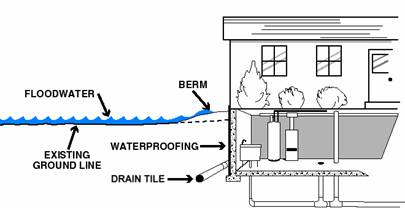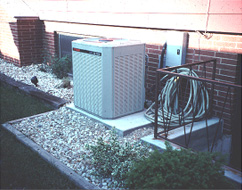Basements
Basement Plumbing
Basement flooding caused by saturated ground can often be corrected by installing a footing drain around the foundation (see illustration). The drain collects groundwater and directs it to a sump. When the sump fills, water is pumped out, usually onto the ground away from the building. Depending on local conditions, the drain and pumping system may have to handle large volumes of water. Basement plumbing problems include cracks, flooding at the sump pump, and sewer backup.

Typical basement drain and sewer arrangement.
Note: Your floor drain may or may not be connected to the sanitary sewer line.
Basement Cracks
Groundwater can seep into your basement around pipes or through cracks in the walls or floor. This may be difficult to determine if the walls have been covered with paneling or other finishing. The best way to deal with a groundwater problem is to waterproof the walls and relieve the water pressure through a footing drain system and sump as illustrated under basement plumbing. Footing drains are typically installed around the perimeter of the house, along the foundation. If this is not possible, drains can be installed on the interior of the basement, along the basement walls, and directed toward the sump pump pit.
Cracks can be repaired and the walls can be waterproofed from inside or outside. Waterproofing on the outside is more effective because groundwater pressure forces the sealer into the foundation. The best technique is to dig a ditch around the basement wall so that you can apply an epoxy sealant to the exterior walls. This can be done by the handyperson (many home maintenance manuals have instructions for this) or a commercial waterproofing company.
Precautions: Waterproofing alone is only recommended for groundwater problems. Surface water will put much more pressure on the building’s walls and can even break them. If the building is affected by surface flooding, you should also install a barrier or basement protection berm.
Sump Pump
Note the sump and sump pump in the basement plumbing graphic. When the sump fills, water is pumped out, usually onto the ground away from the building. Depending on local conditions, the drain and pumping system may have to handle large volumes of water.
If the pump gets overloaded, or if there is a loss of power, the system designed to keep groundwater out of your basement can act as a conduit to bring water in. You can prevent sump flooding by doing one or more of these floodproofing projects:
- Install a larger sump pump
- Add a second battery backup sump pump
- Be certain that downspouts are not connected to the footing drain
- Make sure the downspouts drain away from the house
- Redirect the downspouts and sump pump outfall farther away from the house
- Run the sump pump outfall above ground level or use a check valve to prevent back flow
Precautions: When there is water in your basement, it is hard to tell how it got in. It’s a good idea to check for cracks in the walls and install sewer backup protection, too. Using a battery backup sump pump is the safest alternative, plus you do not have to be home to start it. If your existing backup sump pump uses a generator for a power source, be sure the generator is set up outside (where it won’t flood) or vented to the outside to direct deadly carbon monoxide exhaust fumes outdoors.
Basement Protection Berm

Basement protection berm
Basements and the lower floors of split levels can be protected from surface water by construction of low walls around stairwells or using backfill. Waterproofed walls, sewer backup protection, drain tile and a sump pump are a must. The drains and pumps can keep up with the seepage before it gets through the berm and reaches your house.
Walls are built up around the window wells and basement stairwells (don’t block basement windows that are needed for emergency exits). An earthen berm can be filled against the waterproofed side of the house.
A subsurface drain and one or two correctly sized sump pumps are a must. The drains and pumps can keep up with the seepage before it gets through the berm and reaches your house.
The objective is to not let floodwaters touch the house. If water on the surface of the ground gets up against the house, it probably will seep down the gap between the basement walls and the surrounding soil. This will greatly increase the amount of water pressure against the basement walls.

This house is protected by a raised stairwell and
a basement protection berm covered with gravel.
Sump pumps cannot keep up with surface water. If you have sandy or permeable soil, you should consult an engineer or soils expert to ensure that the berm will extend far enough away from the walls.
Don’t forget: filling or grading in your yard requires a permit.
Precautions: The berm can only be built so high. It can be overtopped by a flood higher than expected. Being made of earth, it is susceptible to erosion from rain and floodwaters if not properly sloped and covered with grass and maintained. A berm can settle over time, lowering its protection level. The small floodwalls can crack and lose their watertight seals.
You also need to account for water in the sewer lines, footing drain and sump pump outfall. They may carry water under the barrier and flood inside your house. See sewer backup prevention.

